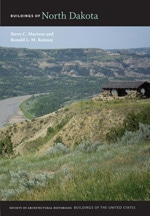You are here
Bremer Bank, Gilby Branch (Bank of Gilby)
This bank and that of Forest River (WA4) are two of several similar Prairie School banks built in small eastern North Dakota towns from 1919 to as late as 1954. Others are in Kindred, Minto, and Sanborn. The banks (especially those at Gilby and Forest River) pose an intruguing conundrum about how credit is assigned to architects for the design of projects. A detailed elevation drawing in Rosatti’s papers shows his 1918 design proposal for the Farmers and Merchants Bank in Forest River, a project for which he justifiably claimed design credit. Local records, however, assert a relationship between Scherer and the Gilby-Forest River bank’s owners and builders and credit Scherer as the architect of record, with responsibility for the design’s strong Prairie Style influence. Both architects were capable of designing competently in this mode, so credit must be assigned to both.
Scherer’s commercial designs are similar to Minnesota banks by Purcell and Elmslie during this same period. Without copying verbatim, the Gilby bank reflects Scherer’s inclinations for the Prairie Style. Ornamentation draws somewhat from classical principles, with embellished columns, terra-cotta capitals, and escutcheons. Framed by substantial brick corners and a cornice, the facade is then subdivided by the two Prairie Style piers and similar smaller piers define the central entrance. Large windows that once spanned the upper part of the facade have been replaced with glass block. Scherer (1890–1956), whose work is better represented in Jamestown, was educated at Collegeville, Minnesota, and practiced for a short time as a partner with Joseph A. Shannon in Devils Lake before returning to the Twin Cities at the onset of the Great Depression. Rosatti used terra-cotta extensively in his work. Given the role of the client in completing a building project, it is conceivable that the bank owners might have changed designers midstream for either the Gilby or Forest River banks or worked with more than one architect to realize the design idea.
Writing Credits
If SAH Archipedia has been useful to you, please consider supporting it.
SAH Archipedia tells the story of the United States through its buildings, landscapes, and cities. This freely available resource empowers the public with authoritative knowledge that deepens their understanding and appreciation of the built environment. But the Society of Architectural Historians, which created SAH Archipedia with University of Virginia Press, needs your support to maintain the high-caliber research, writing, photography, cartography, editing, design, and programming that make SAH Archipedia a trusted online resource available to all who value the history of place, heritage tourism, and learning.















